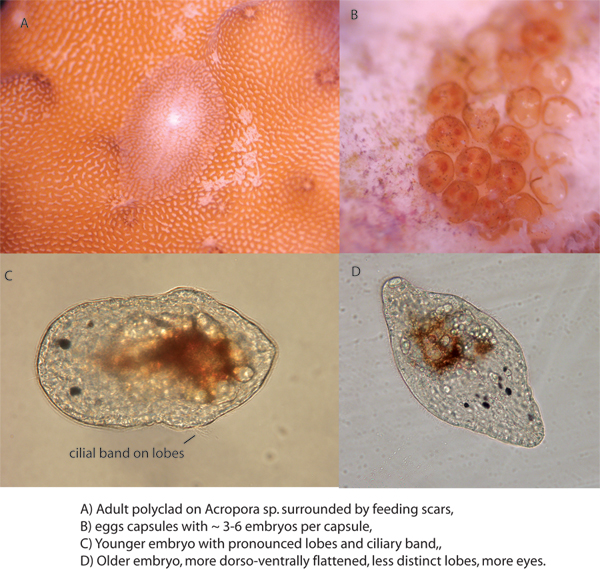AEFW — the dreaded acropora-eating flatworm has been a nuisance for hobbyists for years and has just gotten a new name thanks to a research team led by Dr. Kate Rawlinson from University College London. Amakusaplana acroporae is the official name of the newly described and named polyclad flatworm with the species description and information on it’s development and life history published in the latest issue of the journal Coral Reefs and is the first research study on this particular flatworm. We first touched on this study two years ago when it started as an idea between Eric Borneman and polyclad expert Dr. Rawlinson.
Those of us who have unfortunately had AEFW infestations know these small creatures can reproduce quickly and devastate entire colonies of coral. The team studied the AEFW and through observation and rDNA studies, discovered AEFWs belong to the family Prosthiostomidae and previously monospecific genus Amakusaplana. By comparing the flatworms to the previously lone member of the genus, Amakusaplana ohshimai, enough differentiation was described to justify the classification.

The research was a combined effort of three universities, University College London and Cambridge University in the UK and University of Houston in the US. Specimens were collected from one of the author’s personal tanks in Virginia as well as adult specimens from Atlantis Marine World in Long Island, NY. The team had an open call to hobbyists to share sightings of AEFW in both aquariums and in nature to finish the research.
These coral predators are hard to detect since they camouflage themselves against the host coral quite well due to the ingestion of coral tissue and zooxanthellae in their gut and were observed in sizes up to 17mm long and 10mm wide. Interestingly, the embryonic development of the AEFW is around 21 days with all egg batches observed found on bare coral skeleton as opposed to live tissue. Although they do not know exactly how many egg batches an adult will lay in its lifetime, they did find the number of egg capsules per batch ranged from 20–26 with 3-7 embryos in each capsule.
For those of you intrigued by this breakthrough information, the entire article is only available via a subscription or online purchase but here is the abstract:
Efforts to culture and conserve acroporid corals in aquaria have led to the discovery of a corallivorous polyclad flatworm (known as AEFW – Acropora-eating flatworm), which, if not removed, can eat entire colonies. Live observations of the AEFW, whole mounts, serial histological sections and comparison of 28S rDNA sequences with other polyclads reveal that this is a new species belonging to the family Prosthiostomidae (Lang, 1884) and previously monospecific genus Amakusaplana (Kato 1938). Amakusaplana acroporae is distinguished from Amakusaplana ohshimai by a different arrangement and number of eyes, a large seminal vesicle and dorsoventrally compressed shell gland pouch. Typical of the genus, A. acroporae, lacks a ventral sucker and has a small notch at the midline of the anterior margin. Nematocysts and a Symbiodinium sp. of dinoflagellate from the coral are abundantly distributed in the gut and parenchyma. Individual adults lay multiple egg batches on the coral skeleton, each egg batch has 20–26 egg capsules, and each capsule contains between 3–7 embryos. Embryonic development takes approximately 21 days, during which time characteristics of a pelagic life stage (lobes and ciliary tufts) develop but are lost before hatching. The hatchling is capable of swimming but settles to the benthos quickly, and no zooxanthellae were observed in the animal at this stage. We suggest that intracapsular metamorphosis limits the dispersal potential of hatchlings and promotes recruitment of offspring into the natal habitat. The evolutionary and ecological significance of retaining lobes and ciliary tufts in the embryo are discussed. Camouflage, high fecundity and possible dispersal dimorphisms probably explain how Amakusaplana acroporae can cause Acropora sp. mortality in aquaria where natural predators may be absent.
Great work by Dr. Rawlinson, Mr. Borneman and her team. It is great to have more detailed information on this coral predator and is another notch in the belt for the reefing hobby helping to bring about new scientific research and information on the World’s wild reefs. Thanks to Dustin and the crew at ORA for sending this information our way.



